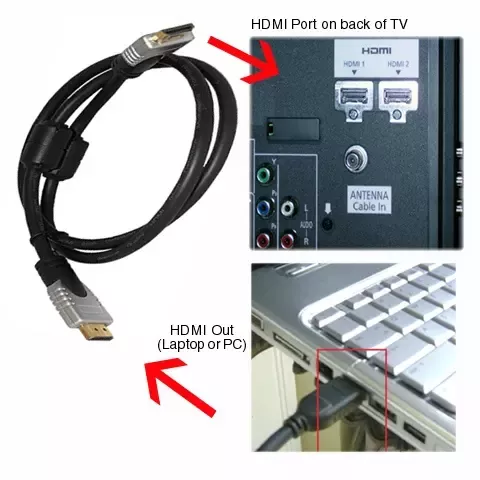Do you want to connect your laptop to the TV to show a presentation, present photos, and videos from your last vacation, or just want to play PC games on the TV? We’ll show you how it works. In this article, we get to know about How to connect laptop to tv?
Just quickly play a presentation on the television or play your favorite PC game on the television? No problem at all, because laptops, MacBooks, and PCs can now be easily connected to your TV at home. Depending on what you want to do, different approaches help. We’ll show you how it works and what you need to connect your laptop to the television.
Table of Contents
Connect laptop (PC) to television: HDMI, USB-Type-C, and DisplayPort
The simplest and most obvious method is to connect it to the television via cable . Here you have three options to choose from, depending on the equipment of your television and the connections of your laptop or PC. You can use the following connections for this:
-
Connection via HDMI cable (also Micro-HDMI)
-
USB Type-C to HDMI
-
DisplayPort or “DisplayPort on HDMI”
Televisions generally have several HDMI connections, but your laptop or PC does not necessarily have to be equipped with an HDMI connection. Newer MacBooks, for example, only have USB Type-C and some graphics cards only have DisplayPort installed.
The connection type is compatible with all televisions directly via cable and does not require additional hardware. You can use these with PCs, iMacs, Windows laptops, MacBooks, and also with Chromebooks. An existing connection is of course required.
So make yourself familiar with the connections on your PC (graphics card), on your laptop or with your MacBook, and then select the appropriate cable. If there is an HDMI connection on both sides, a standard HDMI cable is sufficient. But if your MacBook only has USB Type-C, you need an adapter that converts the signal to HDMI. But here you can find a cheap remedy.
Mirror or second screen to connect laptop to tv?
When you connect your laptop to the television, the question quickly arises, what do you want to do with it? Because there are several methods here too. If you connect your device for the first time, for example, the display of the MacBook or the laptop with Windows 10 is mirrored. This means that the picture from the display of your mobile device is transmitted 1: 1 to the television.
The advantage of the cable connection and an intelligent operating system: The resolution is adapted to the television. So you don’t have to worry about great bars on the sides in the display, even if some laptops such as the MacBook from Apple use a different format for the display.
With Windows 10 and macOS you also have the option of using the TV as a second screen. This expands the display and allows you to move the windows and programs you need between the laptop display and the television. All you have to do is go to the display settings and set up the second screen. In Windows 10 you can find these settings in the Control Panel in the “Display” area and in macOS in the system settings under “Monitors”.
Connect laptop wirelessly to TV: With Google Chrome via Chromecast
If you don’t necessarily want to have a cable dangling between the TV set and laptop, you can also use additional hardware and simply start streaming via a wireless connection. This is made possible, for example, by Google Chromecast using special programs on your laptop, MacBook or Chromebook.
In this case, that would be the Chrome browser, which is fully compatible with the Cast protocol. This will transfer your browser tabs displayed in Chrome to the Chromecast dongle on the television. For example, you can display the Netflix website, play YouTube videos or use Google Docs and other apps to display presentations or even hold a slide show.
However, the Google Chromecast must be set up on television. In our Chromecast guide we explain to you what you have to pay attention to with the Chromecast, how the protocol works, and how you get your dongle ready to go :
Connect MacBook to TV with AirPlay 2: The wireless alternative for Mac
If you are already out and about in the Apple universe and even have an Apple TV 4K at home, then AirPlay 2 is of course the best alternative for you. Simply connect the Apple TV to any television and log it into the same home network as your MacBook. Already it can actually start.
To do this, click on the small screen icon in the system bar in the upper right corner and then select the Apple TV that is displayed there. The screen of your MacBook or an iMac is mirrored on the television with almost no latency. The small symbol can also be found in various programs or apps, where you can, for example, start the transmission to the television directly from a video.
Apple AirPlay 2
Since 2019, however, some televisions have also been able to use the Apple AirPlay 2 interface, so that no Apple TV 4K is required. Manufacturers such as Samsung, Sony, or LG now offer AirPlay 2 in many series out of the box. Disadvantage: The televisions must have a year of manufacture from 2019 and are mostly in the middle and upper class. You can find a comprehensive list of all supported televisions in the compatibility list in our AirPlay 2 guide.
So it depends on the intended use, but there is actually no simpler connection between MacBooks and your television. However, in this case, you are dependent on additional hardware and a new Apple TV 4K costs well over 100 euros. But you also get a modern and powerful set-top box.
Microsoft Wireless Display Adapter: Miracast as plug-and-play for retrofitting
Microsoft’s own alternative for transmitting content to any television. Or monitor with an HDMI connection flies a little under the radar. The Microsoft Wireless Display Adapter costs around 65 euros. And can be purchased from the software giant’s in-house online shop. It is connected to a free HDMI port on your television and supplied with power via USB. He uses the old Miracast protocol.
Bottom Line to connect laptop to tv
The Windows operating system already supports the interface and the transmission to the television should not be a major problem. This means that tablets, PCs and laptops with Microsoft’s operating system can usually be used via the Microsoft dongle. However, systems with macOS such as MacBooks or iMacs are not compatible. Also, Chromebooks can not use Miracast.

However, not all Windows versions can use all functions . Microsoft specifies full support for the wireless display adapter from Windows 8.1. Windows 7 and some versions in between should only offer limited functionality for the transfer. Versions older than Windows 7, however, no longer work with the adapter.
Also read: how long does it take to digest food


